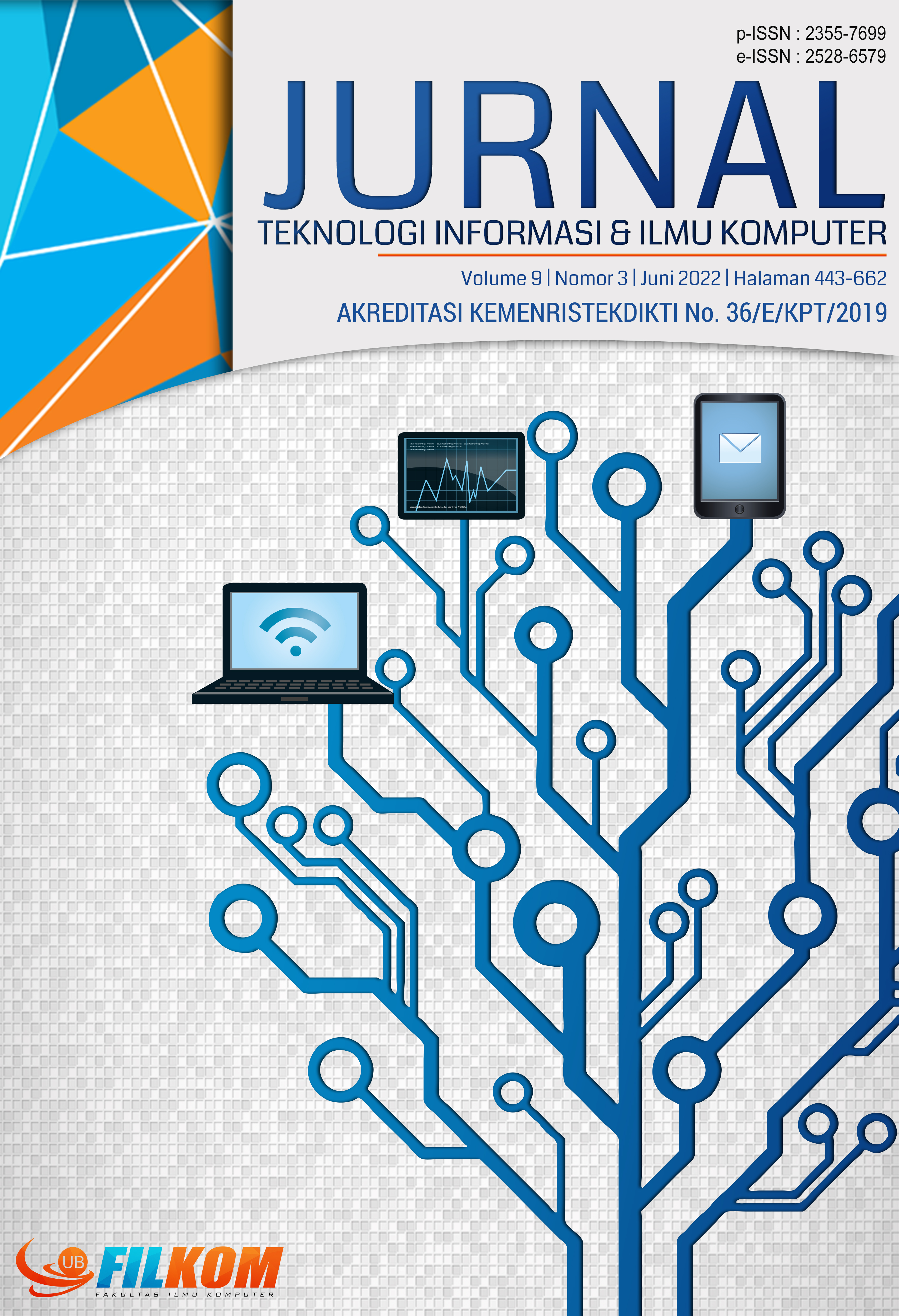Desain Interaksi Aplikasi Zero Waste dengan Menerapkan Gamifikasi Menggunakan Pendekatan Player-Centered Design
DOI:
https://doi.org/10.25126/jtiik.2022935180Abstrak
Berdasarkan Indeks Perilaku Ketidakpedulian Lingkungan Hidup (IPKLH), menunjukkan bahwa tingkat ketidakpedulian masyarakat Indonesia terhadap pengelolaan sampah masih tinggi. Salah satu cara untuk meningkatkan kepedulian adalah memberikan edukasi penerapan zero waste melalui aplikasi mobile. Desain interaksi menjadi faktor penting dalam mengembangkan aplikasi, agar efektif bagi pengguna untuk peningkatan kepedulian lingkungan. Beberapa situs web terkait zero waste yang ada cenderung menyerupai e-commerce penjualan produk zero waste dan blog. Penelitian-penelitian sebelumnya menunjukkan bahwa penerapan gamifikasi pada sebuah sistem dapat meningkatkan motivasi seseorang dalam belajar dan dapat mengubah perilakunya. Penelitian ini bertujuan untuk mengembangkan desain interaksi aplikasi zero waste guna meningkatkan motivasi masyarakat dalam menerapkan prinsip zero waste melalui penerapan gamifikasi. Pengembangan desain interaksi ini dilakukan menggunakan metode player-centered design yang dalam pengembangannya menggunakan prinsip gamifikasi dengan tahapan memahami pemain, misi, motivasi pengguna, menerapkan mekanik game, dan monitor. Fitur yang dirancang mengacu pada Taksonomi Bloom, yaitu untuk mengaplikasikan suatu hal, seseorang harus mengetahui dan memahaminya terlebih dahulu. Prototipe desain interaksi high fidelity ini dibangun untuk memenuhi usability goals yaitu effective to use dan efficient to use serta user experience goals yaitu helpful dan motivating. Ketercapaian usability goals dan user experience goals diukur secara kuantitatif menggunakan metrik Success Rate dengan skor 86,4% untuk effective to use, System Usability Scale (SUS) dengan skor 86,5 untuk efficient to use, Intrinsic Motivation Inventory (IMI) subskala value/usefulness sebesar 6,31 untuk helpful, dan IMI subskala interest/enjoyment sebesar 5,97 untuk motivating. Berdasarkan pengukuran tersebut, disimpulkan bahwa user experience goals dan usability goals dari desain interaksi ini sudah tercapai.
Abstract
According to the Environmental Indifference Behavior Index (IPKLH), the level of indifference to waste management by Indonesians is still on a high level. One way to increase awareness is to provide education towards a zero-waste lifestyle using a mobile platform. Design interaction turns into a key factor to develop the effectiveness toward application for increasing environmental indifference. Several zero waste-based websites are similar to blog and zero waste product selling e-commerce. In earlier research shows gamification applied to a system could lead to improve an individual motivation toward studying by also transform their behavior. This research intends to develop zero waste application design interaction to escalate people motivation for applying zero waste fundamental by using gamification appliance. The application is developed with a player-centered design approach, using gamification principles to increase user motivation, starts with understanding the players, the mission, the motivation, defining the game mechanics, and monitoring. The features designed in the application refer to Bloom's Taxonomy, which states that to be able to apply something, one must know and understand it. The output of this project is a high-fidelity prototype that meets several usability goals and user experience goals. The usability goals are effective to used and efficient to use, and the user experience goals are helpful and motivating. Using the success rate metric, the result of the measurement for effectivity goal is 86.4%. For the efficiency goal, the result of the measurement using the System Usability Score (SUS) metric is 86.5. Using the Intrinsic Motivation Inventory, the score for the value/usefulness subscale for helpful goal is 6.31 and for the interest/enjoyment subscale is 5.97 for the motivating goal. Based on these measurements, it can be concluded that this application has achieved the user experience goals and usability goals.
Downloads
Referensi
BADAN PUSAT STATISTIK. 2018. Laporan Indeks Perilaku Ketidakpedulian Lingkungan Hidup Indonesia. Jakarta: Badan Pusat Statistik
HAMARI, J. 2019. Gamification. The Blackwell Encyclopedia of Sociology. Tersedia di https://doi.org/10.1002/9781405165518.wbeos1321
JAMBECK, J. R., GEYER, R., WILEOX, C., SIEGLER, T. R., PERRYMAN, M., ANDRADY, A., LAW, L. K. 2015. Plastic waste inputs from land into the ocean. Washington: American Association for the Advancement of Science
KLOCK, A. C., GASPARINI, I., PIMENTA, M. S., & HAMARI, J. 2020. Tailored gamification: A review of literature. International Journal of Human-Computer Studies. Tersedia di https://doi.org/10.1016/j.ijhcs.2020.102495. [Diakses 13 Februari 2021]
KUMAR, J. M., & HERGER, M. 2013. Gamification At Work: Designing Engaging Business Software. Denmark: Interaction Design Foundation
LAUBHEIMER, P. 2018. Beyond the NPS: Measuring Perceived Usability with the SUS, NASA-TLX, and the Single Ease Question After Tasks and Usability Tests. Diambil kembali dari Nielsen Norman Group: Tersedia di https://www.nngroup.com/articles/measuring-perceived-usability
MARACHE-FRANCISCO, C., & BRANGIER, E. 2013. Process of Gamification: From The Consideration Of Gamification To Its Practical Implementation. CENTRIC 2013 : The Sixth International Conference on Advances in Human-oriented and Personalized Mechanisms, Technologies, and Services (hal. 127-131). Wilmington: IARIA.
SAURO, J. 2011, September 6. 10 Things To Know About Completion Rates. Tersedia dan diambil kembali dari MeasuringU: https://measuringu.com/completion-rates/
SHAHBAZI, S., WIKTORSSON, M., KURDVE, M., JÖNSSON, C., & BJELKEMYR, M. 2016. Material efficiency in manufacturing: swedish evidence on potential, barriers and strategies. Journal of Cleaner Production, 127, 438–450.
ZICHERMANN, G., & CUNNINGHAM, C. (2011. Gamification by Design: Implementing Game Mechanics in Web and Mobile Apps. Sebastopol: O'Reilly Media
Unduhan
Diterbitkan
Terbitan
Bagian
Lisensi

Artikel ini berlisensi Creative Common Attribution-ShareAlike 4.0 International (CC BY-SA 4.0)
Penulis yang menerbitkan di jurnal ini menyetujui ketentuan berikut:
- Penulis menyimpan hak cipta dan memberikan jurnal hak penerbitan pertama naskah secara simultan dengan lisensi di bawah Creative Common Attribution-ShareAlike 4.0 International (CC BY-SA 4.0) yang mengizinkan orang lain untuk berbagi pekerjaan dengan sebuah pernyataan kepenulisan pekerjaan dan penerbitan awal di jurnal ini.
- Penulis bisa memasukkan ke dalam penyusunan kontraktual tambahan terpisah untuk distribusi non ekslusif versi kaya terbitan jurnal (contoh: mempostingnya ke repositori institusional atau menerbitkannya dalam sebuah buku), dengan pengakuan penerbitan awalnya di jurnal ini.
- Penulis diizinkan dan didorong untuk mem-posting karya mereka online (contoh: di repositori institusional atau di website mereka) sebelum dan selama proses penyerahan, karena dapat mengarahkan ke pertukaran produktif, seperti halnya sitiran yang lebih awal dan lebih hebat dari karya yang diterbitkan. (Lihat Efek Akses Terbuka).















